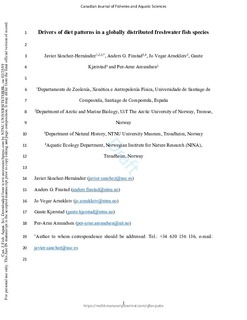| dc.contributor.author | Javier, Sánchez-Hernández | |
| dc.contributor.author | Finstad, Anders Gravbrøt | |
| dc.contributor.author | Arnekleiv, Jo Vegar | |
| dc.contributor.author | Kjærstad, Gaute | |
| dc.contributor.author | Amundsen, Per-Arne | |
| dc.date.accessioned | 2019-03-01T11:25:12Z | |
| dc.date.available | 2019-03-01T11:25:12Z | |
| dc.date.created | 2019-02-25T09:29:47Z | |
| dc.date.issued | 2018 | |
| dc.identifier.issn | 0706-652X | |
| dc.identifier.uri | http://hdl.handle.net/11250/2588234 | |
| dc.description.abstract | We analysed data of a globally distributed model organism (brown trout) in an attempt to understand relationships among biogeography, prey communities and climate on diet composition at regional spatial scales (Scandinavia), and thereafter explored whether diet patterns remained the same at global scales. At regional scales, we uncovered comprehensive patterns in diet composition among neighbouring freshwater ecoregions, with site-specific prey communities as the best predictor of the observed prey utilisation patterns. Thus, we posit that environmental gradients altering site-specific prey communities and consequently the trophic niche of the predator through bottom-up mechanisms are key in understanding spatial dietary patterns. Proximity was also important for the revealed biogeographic patterns at global scales. We suggest that geographic location (latitude and elevation) as a proxy of environmental heterogeneity is key at small spatial scales, and climate at global extents, to understand spatial dietary patterns. Our findings support the hypothesis that future shifts in prey communities due to climate change will strengthen biographical patterns in feeding of freshwater fishes, with consequences for invasiveness assessment and nature management and conservation. | nb_NO |
| dc.language.iso | eng | nb_NO |
| dc.publisher | NRC Research Press (Canadian Science Publishing) | nb_NO |
| dc.title | Drivers of diet patterns in a globally distributed freshwater fish species | nb_NO |
| dc.type | Journal article | nb_NO |
| dc.type | Peer reviewed | nb_NO |
| dc.description.version | acceptedVersion | nb_NO |
| dc.source.journal | Canadian Journal of Fisheries and Aquatic Sciences | nb_NO |
| dc.identifier.doi | https://doi.org/10.1139/cjfas-2018-0207 | |
| dc.identifier.cristin | 1680273 | |
| dc.description.localcode | © 2018. This is the authors' accepted and refereed manuscript to the article. The final authenticated version is available online at: https://doi.org/10.1139/cjfas-2018-0207 | nb_NO |
| cristin.unitcode | 194,31,10,0 | |
| cristin.unitname | Institutt for naturhistorie | |
| cristin.ispublished | true | |
| cristin.fulltext | postprint | |
| cristin.qualitycode | 1 | |
